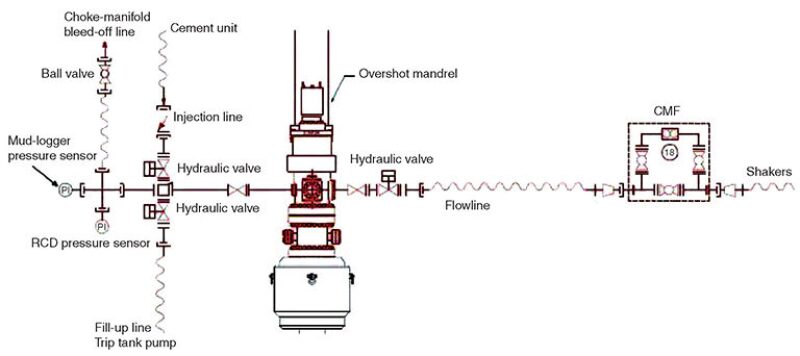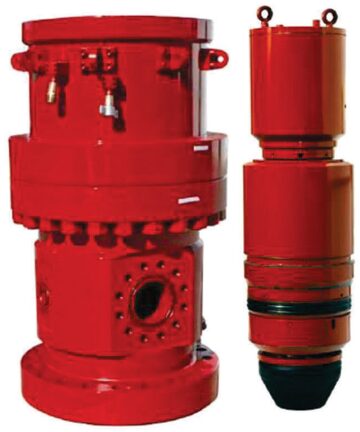Pressurized-mud-cap drilling (PMCD) and early kick detection (EKD) are two unconventional drilling techniques that have been used widely individually, mostly in relation to closed and pressurizable systems and to managed-pressure-drilling (MPD) applications. The techniques, however, are seldom used together as an integrated setup. This paper describes a synergized PMCD and EKD setup and the field deployment where it was used to drill a well successfully offshore Kalimantan, Indonesia, that had a high-pressure formation below a zone prone to severe circulation losses.
Introduction
Many drilling problems offshore Kalimantan involve lost-circulation problems and unintended influxes. Drilling conventionally through fractured and extremely vugular carbonate formations, which are prone to severe lost-circulation problems, can lead eventually to well-control situations. Aside from that, significant time and resources are required to cure the losses before conventional drilling can be continued. In addition, of 1,000 ft of carbonate formation drilled offshore Kalimantan, the fractures often are present in layers, which will multiply considerably the time and resources spent each time severe or total loss is encountered. One of the more well-known ways to mitigate this problem is implementation of the variant of MPD called PMCD, which enables the operator to drill through the fractured formation safely and efficiently.
Meanwhile, also in offshore Kalimantan, most of the zone that resides just several feet below the fractured carbonate formation is highly pressurized gas reservoir. Drilling conventionally through such a pressurized zone exposes the operation to greater risk because of a lack of precision in detecting any influx or outflux during the drilling operation. A better method for detecting influx is the use of a flowmeter to monitor the flow from the well. The most common flowmeter used is a Coriolis mass flowmeter (CMF). Although the CMF has the advantage of great precision in measuring flow rates, the conventional setup lacks accuracy because the system is open to the atmosphere. A further improvement is to use it in conjunction with the MPD system to create a closed-loop system that will increase accuracy. This is the EKD system.
PMCD
MPD is defined by the International Association of Drilling Contractors (IADC) as “an adaptive drilling process used to more precisely control the annular pressure profile throughout the wellbore.” The objectives of MPD are “to ascertain the downhole pressure environment limits and to manage the annular hydraulic pressure profile accordingly.” The IADC differentiates MPD from underbalanced drilling by stating that “MPD is intended to avoid continuous influx of formation fluids to the surface. Any influx incidental to the operation will be safely contained using an appropriate process.”
PMCD is defined by IADC as the variation of MPD that involves “drilling with no returns to surface, where an annulus fluid column, assisted by surface pressure, is maintained above a formation that is capable of accepting fluid and cuttings.” In PMCD, instead of drilling mud, a sacrificial fluid, usually water or seawater, whichever is available, is pumped down the drillstring. This volume, together with the cuttings, is pumped into the lost-circulation zone. High-viscosity pills are also pumped down the drillstring before a connection is made to ensure proper hole cleaning and that cuttings generated during drilling are swept into the lost-circulation zone.
In PMCD mode, both the annular backpressure and the standpipe pressure are monitored for downhole drilling conditions as drilling progresses, primarily whether the formation being drilled is taking all the cuttings and fluids being pumped into it or whether there is still free fluid flow through the drillstring. Torque and drag values are also monitored to determine if there is proper hole cleaning.
EKD
Identifying kick or loss at the beginning of the event, when volumes are still small, increases the chance of controlling the wellbore before the operation escalates to a well-control problem, especially when drilling through a depleted zone or a gas-bearing reservoir. Drilling through that kind of section poses a higher safety hazard, both to the well and to personnel.
Using a closed-loop circulation system to contain drilling fluids by use of a rotating control device (RCD) provides source data for well-flow monitoring and measurement. Combining this system with an EKD system allows for identification of kick or loss as early as possible. The system also allows the operator to identify other wellbore events during drilling, not just influx and losses. These include relatively harmless events such as well breathing and ballooning. The detection of these other events can prevent rig downtime resulting from misdiagnosis.
In addition to the RCD, which creates a closed-loop system, the EKD system uses the following equipment:
- EKD manifold. An EKD manifold contains the following components:
- CMF. A CMF is a device that measures mass-flow rate of a liquid traveling through a tube.
- Intelligent control unit (ICU). The ICU is the brain of the integrated monitoring system, providing algorithms and data acquisition and enabling real-time operation monitoring.
- Isolation valves. Three isolation valves allow two modes of flow through the manifold—flow through the CMF and flow bypassing the CMF. The manifold design allows quick change to the system to allow flow to pass through or to bypass the flowmeter.
- EKD software. This software analyzes and trends all available parameters provided from the well, using a predetermined hydraulics model, and, hence, allows the system to define if a kick or a loss has occurred.
- Other measurement input. The EKD system provides other key measurement inputs, such as
- Surface backpressure sensor (casing-pressure sensor)
- Standpipe-pressure sensor
- Pump-stroke counter
Drilling Setup in Offshore Kalimantan
The drilling setup in offshore Kalimantan (Fig. 1) allows four different modes of drilling in one setup—conventional drilling, closed-loop-circulation drilling, PMCD, and EKD. The main physical difference between the conventional-drilling mode and the other modes is the installation of an RCD-bearing assembly (Fig. 2), which diverts the return directly to the flowline. In offshore Kalimantan, the conventional mode is typically used on the upper section where no loss or gas migration is expected.

When drilling a section where severe losses are expected, the second mode, or closed-loop-circulation drilling, is recommended. Installing a bearing assembly on the RCD will switch the conventional-drilling mode to closed-loop-circulation-drilling mode, and the fluid return will go through the RCD flowline instead of the rig diverter.

In addition to the RCD flowline, three other lines are usually lined up to the RCD—an injection line, a fill-up line, and a bleed-off line. If total loss is encountered and zero return is confirmed, the RCD-flowline valve can be closed remotely to switch to PMCD mode. To begin the injection test, the injection valve of the injection line on the RCD must be opened and lined up with a mud pump or cementing pump. This injection line is used solely for bullheading or filling the annulus during PMCD and must not be used as a kill line during a well-control situation. During a tripping operation, the fill-up line of the RCD is used to fill up the hole because of pipe displacement with a trip tank pump. In some operations, this line is also lined up for deep-well pumping, which can be used to flood the annulus if necessary.
If a change of the RCD-bearing-assembly sealing element is required in the middle of PMCD, the pipe ram or annular blowout preventer should be closed to isolate the well. Then, any gas or pressure in between can be bled off through the bleed-off line on the RCD.
When drilling a section where high-pressure reservoir is expected, the EKD mode is recommended. Installing an RCD-bearing assembly and lining up the RCD flowline to the CMF will switch the drilling mode to EKD. In EKD mode, all fluid returning or flowing out will be measured by the CMF and compared in real time against the inflow. Any gain or loss from the comparison will be displayed directly on the monitor in the driller’s cabin. The system automatically detects any influx or loss and displays alarms.
In addition to influx and loss detection, the EKD system also is able to detect ballooning events.
Field experience with this setup has produced positive feedback from both the client and the drilling contractor. The simplicity of switching between different drilling modes with the existing equipment is the main highlight of the feedback. However, more engineering study and improvement are needed to enhance the capability of the setup further.
Conclusion
The drilling operation offshore Kalimantan has taken a major step to include MPD operation as part of its drilling program through an extremely fractured and vugular formation overlying a high-pressure reservoir. The MPD setup installed is able to work very well with the existing rig system. Switching between drilling modes can be performed in relatively short time, but good understanding is needed of MPD-line setup by both drilling contractors and MPD personnel. Of the two MPD techniques introduced, PMCD allows drilling to continue safely when total loss is encountered and EKD allows enhanced well monitoring for gain and loss when drilling through high-pressure reservoirs.
This article, written by Special Publications Editor Adam Wilson, contains highlights of paper SPE 165893, “Combining Pressurized-Mud-Cap-Drilling and Early-Kick-Detection Techniques for Fractured Formations Overlying a High-Pressure Reservoir in Offshore Kalimantan,” by Benny Benny, SPE, Andri M. Hidayat, Ardia Karnugroho, SPE, Julius Sosa, and Julmar Shaun S. Toralde, SPE, Weatherford, prepared for the 2013 SPE Asia Pacific Oil and Gas Conference and Exhibition, Jakarta, 22–24 October. The paper has not been peer reviewed.

